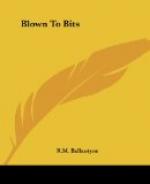Honey-bees in Borneo hang their combs, to be out of danger no doubt, under the branches of the Tappan, which towers above all the other trees of the forest. But the Dyaks love honey and value wax as an article of trade; they therefore erect their ingenious bamboo ladder—which can be prolonged to any height on the smooth branchless stem of the Tappan—and storm the stronghold of the bees with much profit to themselves, for bees’-wax will purchase from the traders the brass wire, rings, gold-edged kerchiefs and various ornaments with which they decorate themselves. When travelling, the Dyaks use bamboos as cooking vessels in which to boil rice and other vegetables; as jars in which to preserve honey, sugar, etc., or salted fish and fruit. Split bamboos form aqueducts by which water is conveyed to the houses. A small neatly carved piece of bamboo serves as a case in which are carried the materials used in the disgusting practice of betel-nut chewing—which seems to be equivalent to the western tobacco-chewing. If a pipe is wanted the Dyak will in a wonderfully short space of time make a huge hubble-bubble out of bamboos of different sizes, and if his long-bladed knife requires a sheath the same gigantic grass supplies one almost ready-made. But the uses to which this reed may be applied are almost endless, and the great outstanding advantage of it is that it needs no other tools than an axe and a knife to work it.
At about mid-day the river was reached, and they found a native boat, or prau, which had been sent down to convey them to the Rajah’s village. Here Nigel was received with the hospitality due to a friend of Van der Kemp, who, somehow—probably by unselfish readiness, as well as ability, to oblige—had contrived to make devoted friends in whatever part of the Malay Archipelago he travelled.
Afterwards, in a conversation with Nigel, the professor, referring to those qualities of the hermit which endeared him to men everywhere, said, with a burst of enthusiasm, which almost outdid himself—
“You cannot oonderstant Van der Kemp. No man can oonderstant him. He is goot, right down to zee marrow—kind, amiable, oonselfish, obliging, nevair seems to zink of himself at all, ant, abof all zings, is capable. Vat he vill do, he can do—vat he can do he vill do. But he is sad—very sad.”
“I have observed that, of course,” said Nigel. “Do you know what makes him so sad?”
The professor shook his head.
“No, I do not know. Nobody knows. I have tried to find out, but he vill not speak.”
The Orang-Kaya, or rich man, as this hill chief was styled, had provided lodgings for his visitors in the “head-house.” This was a large circular building erected on poles. There is such a house in nearly all Dyak villages. It serves as a trading-place, a strangers’ room, a sleeping-room for unmarried youths, and a general council-chamber. Here Nigel found the hermit and Moses enjoying a good meal when he arrived, to which he and the professor sat down after paying their respects to the chief.




